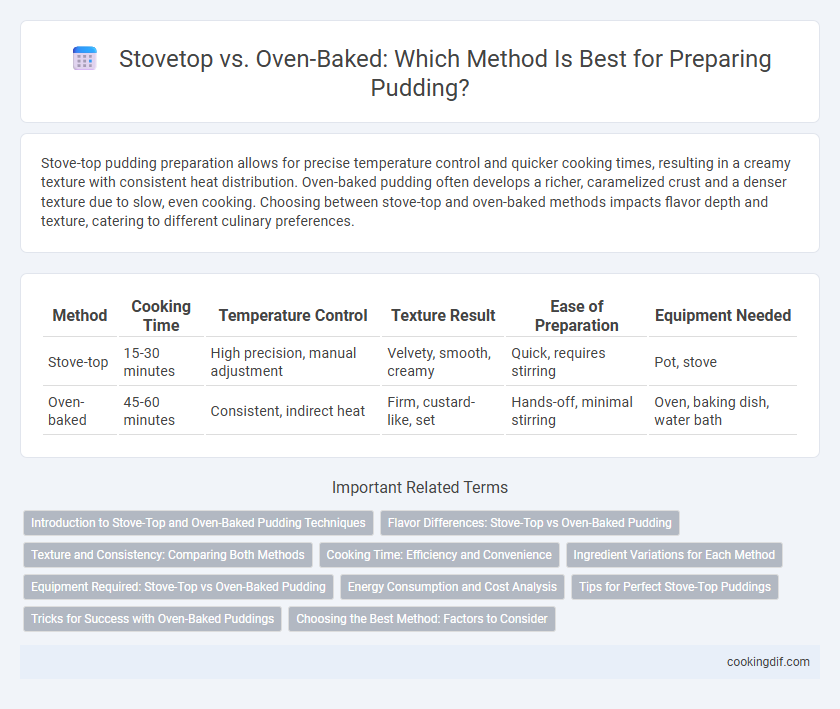Stove-top pudding preparation allows for precise temperature control and quicker cooking times, resulting in a creamy texture with consistent heat distribution. Oven-baked pudding often develops a richer, caramelized crust and a denser texture due to slow, even cooking. Choosing between stove-top and oven-baked methods impacts flavor depth and texture, catering to different culinary preferences.
Table of Comparison
| Method | Cooking Time | Temperature Control | Texture Result | Ease of Preparation | Equipment Needed |
|---|---|---|---|---|---|
| Stove-top | 15-30 minutes | High precision, manual adjustment | Velvety, smooth, creamy | Quick, requires stirring | Pot, stove |
| Oven-baked | 45-60 minutes | Consistent, indirect heat | Firm, custard-like, set | Hands-off, minimal stirring | Oven, baking dish, water bath |
Introduction to Stove-Top and Oven-Baked Pudding Techniques
Stove-top pudding preparation involves gently heating the mixture in a saucepan over simmering water or direct low heat, allowing precise temperature control and faster cooking times while preventing curdling. Oven-baked pudding techniques require placing the pudding mixture in a water bath inside the oven, promoting even heat distribution and a smooth, custard-like texture with minimal risk of scorching. Both methods offer distinct advantages in texture and flavor development, catering to different pudding varieties like bread pudding or traditional custards.
Flavor Differences: Stove-Top vs Oven-Baked Pudding
Stove-top pudding often has a creamier texture with a more pronounced custard-like flavor due to direct heat and frequent stirring, which prevents curdling and promotes even cooking. Oven-baked pudding develops a richer, caramelized flavor and a denser texture from slow, consistent heat that allows sugars to brown and flavors to deepen. Choosing between stove-top and oven-baked methods significantly impacts the final pudding's flavor profile and mouthfeel.
Texture and Consistency: Comparing Both Methods
Stove-top pudding preparation yields a creamier and smoother texture due to constant stirring and controlled heat, preventing lumps and promoting uniform consistency. Oven-baked pudding typically develops a thicker, custard-like structure with a slightly firmer top layer from even, indirect heat exposure. Choosing between methods depends on the desired balance between velvety softness and a set, sliceable pudding consistency.
Cooking Time: Efficiency and Convenience
Stove-top pudding typically cooks faster, often within 15-20 minutes, making it ideal for quick, convenient desserts. Oven-baked pudding requires longer cooking times, usually 45 minutes to an hour, but allows for more even heat distribution and richer texture development. Efficiency in stove-top methods suits busy schedules, while oven baking offers patience-driven depth in flavor and consistency.
Ingredient Variations for Each Method
Stove-top pudding often incorporates more liquid ingredients such as milk or cream to achieve a smooth, custard-like texture, while oven-baked pudding recipes typically use a denser batter with less liquid to allow for rising and setting in the heat. Stove-top methods frequently rely on constant stirring and gradual heating to prevent curdling, favoring ingredients like eggs and cornstarch as thickeners. Oven-baked puddings use leavening agents such as baking powder and may include ingredients like butter and flour for structure, resulting in a more cake-like consistency.
Equipment Required: Stove-Top vs Oven-Baked Pudding
Stove-top pudding preparation requires basic equipment such as a heavy-bottomed saucepan or double boiler for even heat distribution and constant stirring, ensuring smooth texture without burning. Oven-baked pudding demands ovenproof dishes or ramekins, water bath (bain-marie) setup to regulate temperature and prevent curdling, and often a baking tray for stability. Both methods benefit from reliable temperature control tools, but the stove-top method is typically faster and involves less cleanup than baking.
Energy Consumption and Cost Analysis
Stove-top pudding preparation typically consumes less energy due to shorter cooking times and direct heat transfer, resulting in lower utility costs compared to oven-baked methods that require prolonged preheating and sustained temperatures. Oven baking pudding often incurs higher energy consumption, especially electric ovens that use ambient heat, increasing overall cooking expenses. Cost analysis reveals stove-top cooking as a more economical choice for pudding, optimizing energy efficiency and reducing household energy bills.
Tips for Perfect Stove-Top Puddings
To achieve perfect stove-top puddings, maintain a gentle simmer rather than a rolling boil to prevent curdling and uneven texture. Use a heavy-bottomed pan to ensure even heat distribution and stir constantly with a wooden spoon or whisk to avoid lumps. Cover the pan with a tight-fitting lid or foil to trap steam, which helps the pudding set smoothly and enhances its creamy consistency.
Tricks for Success with Oven-Baked Puddings
Oven-baked puddings require precise temperature control and the use of a water bath to ensure even cooking and prevent cracking. Wrapping the baking dish with foil tightly maintains moisture and creates a tender texture. Allowing the pudding to cool slightly before serving helps the flavors meld and improves the overall consistency.
Choosing the Best Method: Factors to Consider
Stove-top pudding preparation offers precise temperature control and quicker cooking times, making it ideal for delicate custards and traditional British suet puddings. Oven-baked methods provide even heat distribution and allow for larger, denser puddings with a creamy interior and caramelized crust, suitable for bread and rice puddings. Factors such as pudding type, desired texture, cooking time, and equipment availability should guide the choice between stove-top and oven-baked methods.
Stove-top vs oven-baked for pudding preparation Infographic

 cookingdif.com
cookingdif.com